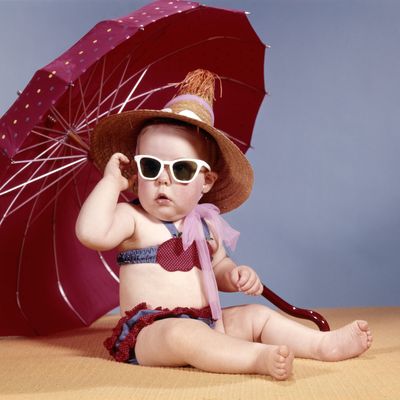
As the sun continues to brutalize New York City, I’m reminded of what a dermatologist told me in June. In short, your derrière is proof that protecting your skin from the sun really does pay off, vanitywise. Minimally exposed to sunlight, your butt skin is supple, virgin, youthful. But to get that butt glow on your face, it’s not enough to throw on the highest SPF you can find and forget about it. Whether you’re trying to look as ageless as Pharrell or because you really, really don’t want to be one of the one in five Americans who get skin cancer, it’s crucial to know what the hell SPF means and what to do about it. And few people do.
As James Hamblin writes for the Atlantic, a 2015 study found that fewer than 50 percent of people could spell out what SPF stands for. (It’s Sun Protection Factor or Sunburn Protection Factor, depending on the institution you ask). Even fewer of the study participants — patients at a dermatology clinic, so you know they had some interest in their skin — could name what the numbers represented. Lots of people thought that SPF 30, quite reasonably, was double the protection of SPF 15. But the difference is slight: SPF 15 blocks 93 percent of UV-B rays, while SPF 30 filters about 97 percent. According to the American Academy of Dermatology, “there is not any scientific evidence that indicates using a sunscreen with an SPF higher than 50 can protect you better than a sunscreen with an SPF of 50.”
Add all of this up, and the reasoning behind why higher SPF may leave people less protected starts to add up. Sunscreen isn’t like deodorant, where you put it on in the morning and it (purportedly) protects you all day; it’s more like Chap Stick, which you have to continuously apply. “The real factors that determine how well a sunscreen works is how much we use and how often we re-apply,” Hamblin writes. “When we feel very well protected, we’re less likely to reapply frequently and to seek shade.” It’s like how bike-helmet laws may, according to one economic analysis, lead to more bike injuries: People feel safer with helmets on, so they ride more recklessly. Further confounding all that, the AAD also finds that most people apply just 25 to 50 percent of the recommended amount of sunscreen (enough to fill a shot glass), and Consumer Reports finds that 43 percent of sunscreen and lip balms fall short of their advertised SPF, often because they suck at being wet, bad news if you expect to sweat or swim on a sunny day. So get a good sunscreen, and put it on. Again and again.




